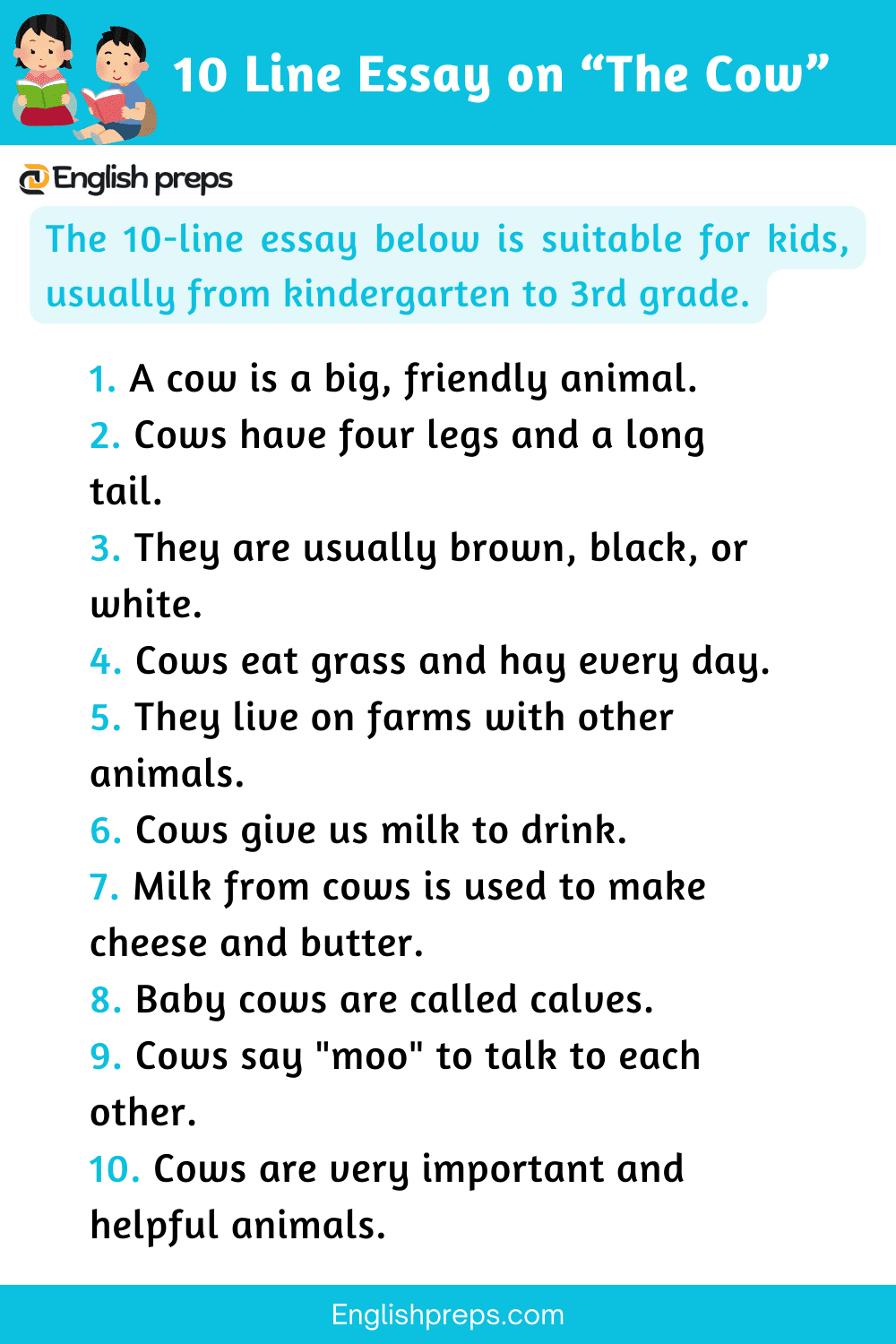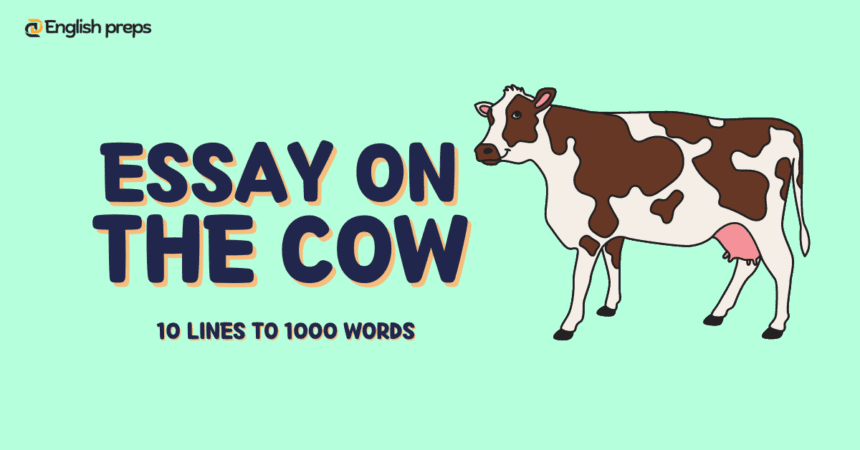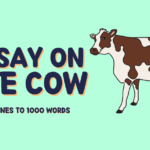Welcome, dear students to this comprehensive collection of Cow essays in English. We are delighted to present to you a wide range of essay samples that cater to varying needs and understanding levels. Whether you seek a concise 10-line essay on the cow or a more elaborate piece spanning from 250 to 1000 words, we have diligently compiled a selection for you to choose from.
When faced with the essay question in the exam, “Write an essay on the Cow,” you can confidently respond with any of these samples that align with the requirements. To ensure ease of access, we have categorized these essays according to their length and language complexity, tailoring them to students from grades 2 to 12.
Table of Contents
Many students search queries like “cow essay in English 10 lines, cow pe essay 10 lines in English, or cow ka essay in English”. So we have provided many samples of the “10 Lines essay on the Cow” below.
The Cow Essay 10 Lines
(Essay on Cow for Class 1 and Class 2 students)

Cow Essay 10 Lines (100 Words)
The Cow essay below is suitable for class 4th and 5th students.
- The cow is a gentle and useful animal.
- It gives us milk, which is good for our health.
- The cow has a big body and a long tail.
- It eats grass and hay.
- Cows are usually white, brown, or black.
- They have four legs and two ears.
- Cows live on farms and are taken care of by farmers.
- They like to stay together in a group called a herd.
- Cows have big, kind eyes.
- They say “moo” and make a sound when they are happy.
Cow pe Essay in English (150 Words)
- The essay below about The Cow is suitable for students in grades 6 to 8.
The cow is a domestic animal that is found all over the world. It is a herbivorous animal that feeds on grass and plants. Cows are known for their gentle and calm nature. They have a large body with four legs and a long tail. Cows are primarily raised for their milk, meat, and leather.
In Hinduism, cows are considered sacred and are worshipped. They play a vital role in agriculture by providing milk and helping in plowing fields. Cows have a complex digestive system called a four-chambered stomach. They communicate with each other through various sounds and body language.
Cows are important to the economy and are valued for their contribution to the dairy and meat industry. We should be kind to cows and treat them well.
Cow Essay in English (250 Words)
- The essay below about The Cow is suitable for students in grades 9 to 10.
The cow is a gentle and friendly animal that is commonly found on farms around the world. It is a large mammal with a big body and four strong legs. Cows have a special stomach that allows them to digest grass and other plants.
One of the most important things about cows is that they provide us with milk. Many people drink milk every day, and it comes from cows. Milk is rich in nutrients like calcium and helps us grow strong and healthy. It is also used to make other delicious dairy products like cheese, butter, and yogurt.
Cows have a unique way of eating. They use their long tongue to grab grass and chew it with their powerful jaws. They have big teeth to help them grind the food. Cows spend a lot of time eating and can eat up to 50 kilograms of food in a single day!
Cows are also known for their distinct sound, which is called “moo.” They use this sound to communicate with other cows and their calves. Cows are social animals and like to live together in groups called herds. They take care of each other and protect their young ones.
Cows are very gentle creatures, and they love to be petted and scratched. They enjoy the company of humans and can even recognize their owners. Cows are also used to pull heavy loads and plow fields in some parts of the world.
In conclusion, cows are amazing animals that provide us with milk and other dairy products. Cows are friendly and enjoy human company. They are an important part of our lives and play a significant role in agriculture.
Cow Essay in English (500 Words)
The cow is a domestic animal that is found in many parts of the world. It is a large mammal that is known for its gentle nature and its usefulness to humans. Cows have been domesticated for thousands of years and are one of the oldest and most important farm animals.
Cows have a distinct appearance with their big bodies and long legs. They have a thick coat of hair that can be different colors, such as black, brown, or white. Their bodies are built for grazing on grass, as they have a specialized digestive system that allows them to break down and digest plant material efficiently.
One of the most important features of cows is their milk production. Cows are known as dairy animals because they produce milk, which is a nutritious and essential food for humans. Milk is rich in vitamins and minerals and is used to make various dairy products like cheese, butter, and yogurt. Many people rely on cows for their daily milk supply.
Cows are also raised for their meat, which is called beef. Beef is a common source of protein in many diets around the world. Cows that are raised for meat are usually larger and heavier than dairy cows. Beef is used in various dishes, such as hamburgers, steaks, and stews.
In addition to milk and meat, cows also provide other useful products. Their skin is used to make leather, which is used to make shoes, belts, and other leather goods. Cow dung, or manure, is a valuable fertilizer that is used to enrich the soil in farming. It helps plants grow better and increases crop yields.
Cows are generally gentle and calm animals. They spend most of their time grazing in fields and are often seen peacefully chewing their cud, which is regurgitated food that they chew again to aid in digestion. Cows are social animals and live in herds. They form strong bonds with their herd members and communicate with each other through various vocalizations and body language.
Caring for cows involves providing them with proper food, water, and shelter. They need a clean and comfortable place to rest and protection from extreme weather conditions. Regular veterinary care is also important to keep them healthy and prevent diseases.
In some cultures, cows are considered sacred animals and are treated with great respect. They are worshipped and are an important part of religious rituals and ceremonies. In many rural areas, cows are also used as working animals, pulling carts or ploughs to help with farming tasks.
In conclusion, the cow is a gentle and useful animal that has been domesticated for thousands of years. It provides us with milk, meat, leather, and fertilizer. Cows are peaceful creatures that live in herds and have a unique digestive system that allows them to efficiently digest plant material. They are an important part of our lives and deserve our care and appreciation.
Cow Essay in English (1000 Words)
Introduction:
The cow is a remarkable animal that plays an essential role in our lives. Cows are often found on farms, and they provide us with various resources and products that benefit both humans and the environment. In this essay, we will explore the importance of cows and their contributions to society in simple and easy-to-understand language.
Description of Cows:
Cows are large, domesticated animals known for their gentle nature. They have sturdy bodies covered in fur and four strong legs that help them move around. Cows are herbivores, primarily feeding on plants and grass. Their mouths are specially designed to chew and grind food due to their unique tooth structure.
Milk and Dairy Products:
Cows are well-known for the milk they produce. Milk is a nutritious beverage consumed by people of all ages. It is rich in calcium, vitamins, and proteins, which contribute to the growth and development of our bodies. From milk, various dairy products such as butter, cheese, yogurt, and ice cream can be produced, all of which are enjoyed by many people.
Leather and Skins:
Aside from providing milk and dairy products, cows also offer valuable resources such as leather and skins. The cow’s skin is processed to create leather, which is used for making shoes, belts, bags, and other leather goods. Leather is a durable and versatile material widely used in the fashion industry.
Meat:
Cows also provide us with meat, which is an important source of protein in our diet. Beef, the meat of a cow, is consumed in many parts of the world and is used in various dishes such as burgers, steaks, and stews. The meat industry depends on cows to meet the demand for beef.
Fertilizer:
Cows contribute to the environment by producing natural fertilizer. Cow dung, also known as manure, is a valuable resource for farming. Farmers use cow manure to enrich the soil and enhance the growth of crops. It helps retain moisture, improves soil structure, and provides essential nutrients to plants, reducing the need for chemical fertilizers.
Energy Production:
Cows also play a role in the production of renewable energy. Their waste, such as cow dung and leftover plant material, can be converted into biogas through a process called anaerobic digestion. Biogas is a renewable energy source that can be used for cooking, heating, and generating electricity. This helps reduce our reliance on fossil fuels and contributes to a cleaner environment.
Oxen and Farming:
Another significant contribution of cows is their use as working animals. Oxen, which are castrated male cows, have been used for centuries to help with farming tasks. They are trained to pull heavy loads, plow fields, and transport goods. The strength and endurance of oxen make them valuable allies in agriculture, especially in areas where modern machinery is not available or affordable.
Symbolism and Cultural Importance:
Cows hold cultural and religious significance in many parts of the world. In some countries, cows are considered sacred and are worshipped as symbols of fertility, abundance, and divinity. They play a central role in religious ceremonies and festivals. Additionally, cows have become iconic representations of rural life and are often associated with peacefulness, simplicity, and the beauty of nature.
Breeds of Cows:
There are various breeds of cows, each with its distinct characteristics. Some popular breeds include Holstein, Jersey, Angus, Hereford, and Brahman. Holstein cows are known for their high milk production, while Jersey cows produce milk with a higher butterfat content, making it ideal for cheese production. Angus and Hereford breeds are primarily raised for their meat, as they have well-marbled, flavorful beef. Brahman cows are known for their adaptability to hot climates and resistance to diseases.
Cows and Grassland Preservation:
Cows play a vital role in the maintenance and preservation of grasslands. Grazing animals like cows help prevent the overgrowth of grass and promote its healthy growth. By consuming grass, cows also help control weeds, maintaining a balanced ecosystem. Their grazing patterns stimulate new plant growth and help sustain a diverse range of plant and animal species within grassland ecosystems.
Cow Behavior and Social Structure:
Cows are social animals that form strong bonds with their herd members. They exhibit complex social behaviors and establish a hierarchical structure within their group. In a herd, there is usually a dominant female called the “alpha cow.” Cows communicate with each other through various vocalizations, body language, and even specific scents. Their social nature enhances their overall well-being and contributes to their overall health and productivity.
Emotional Bond between Humans and Cows:
Cows have a unique ability to form emotional connections with humans. Many farmers and individuals who work closely with cows often develop a bond with these animals. Cows can recognize familiar faces and respond positively to gentle and caring interactions. This bond between humans and cows not only enhances the well-being of both parties but also fosters a sense of responsibility and respect towards these animals.
Cow Welfare and Ethical Farming Practices:
With increasing awareness of animal welfare, ethical farming practices are gaining importance. It is crucial to provide cows with proper care, comfortable housing, nutritious feed, and access to clean water. Ethical farming focuses on minimizing stress and ensuring the overall well-being of cows. This includes allowing them to engage in natural behaviors such as grazing, socializing, and resting.
Conclusion:
In conclusion, cows are remarkable animals that contribute significantly to our lives. They provide us with milk, dairy products, meat, leather, and other valuable resources. Cows also play a role in sustainable agriculture, energy production, and cultural practices. Their gentle nature and the benefits they offer make them an important and cherished part of our society.






